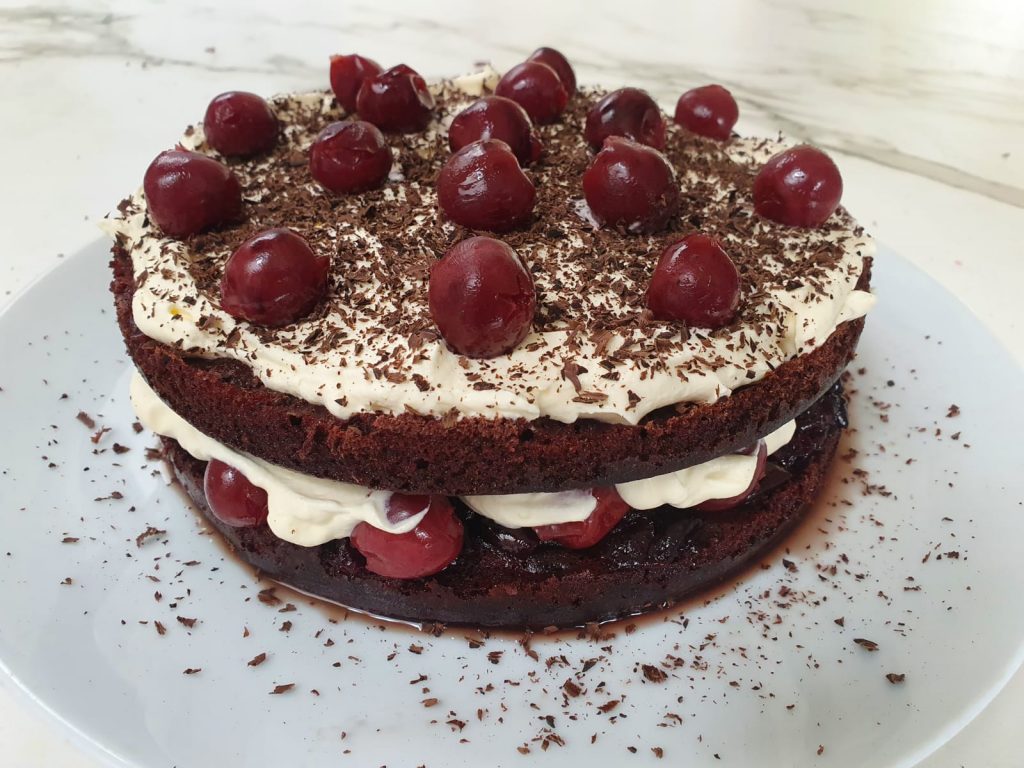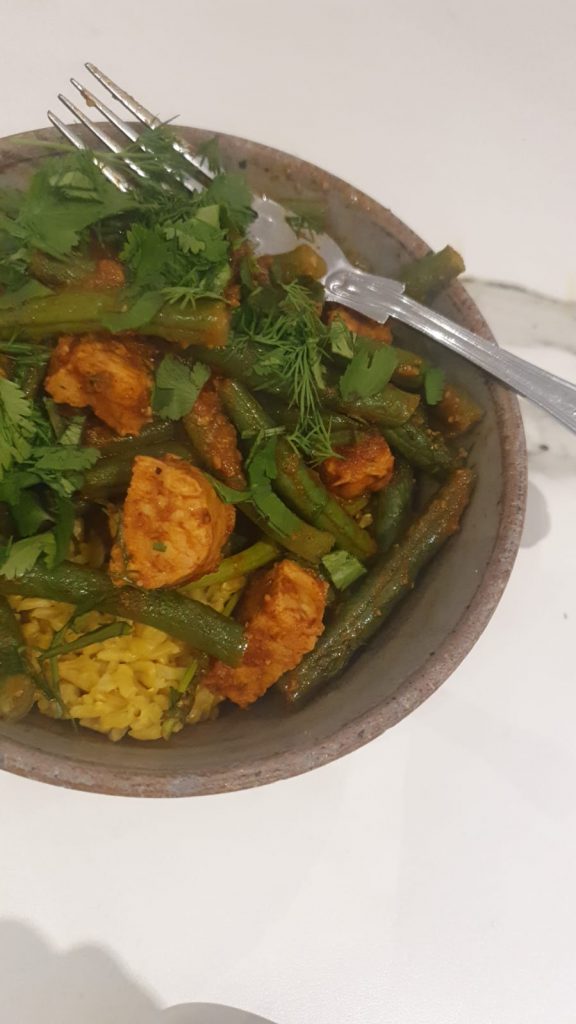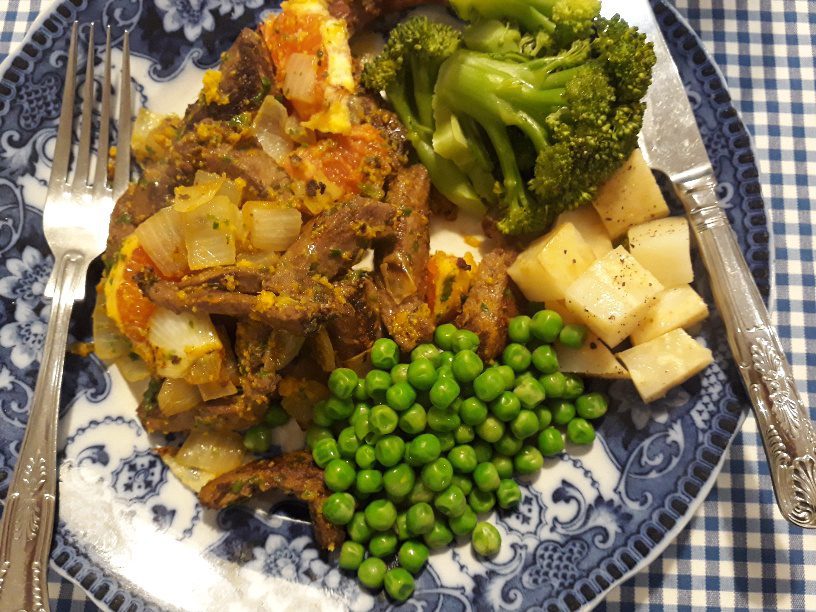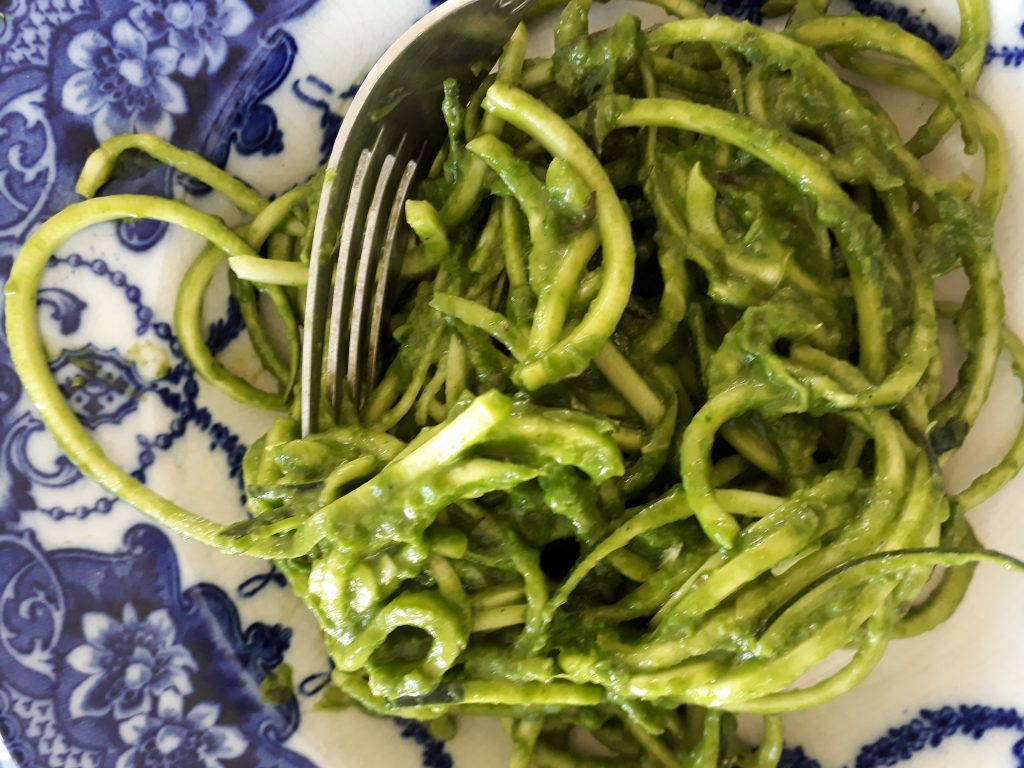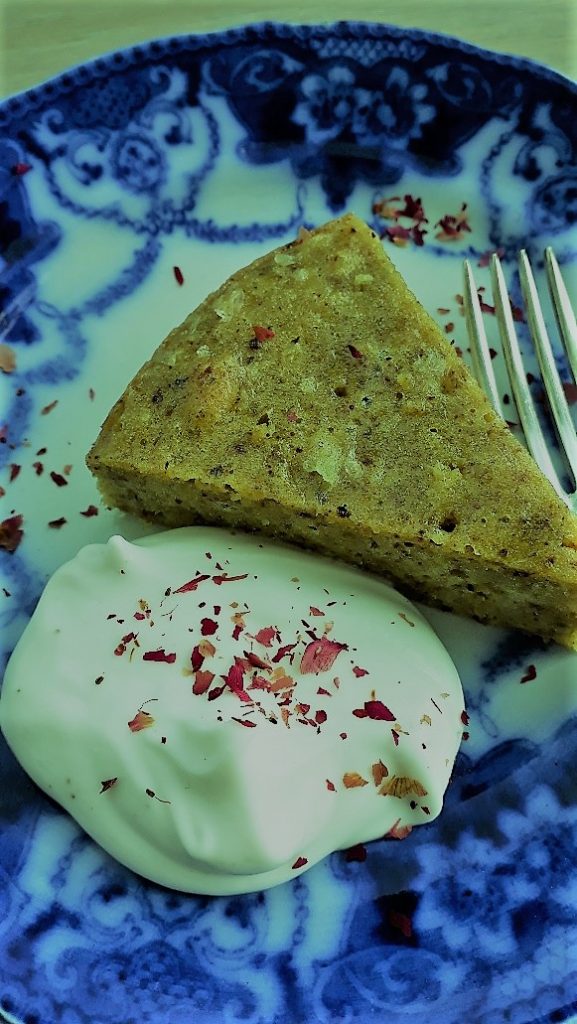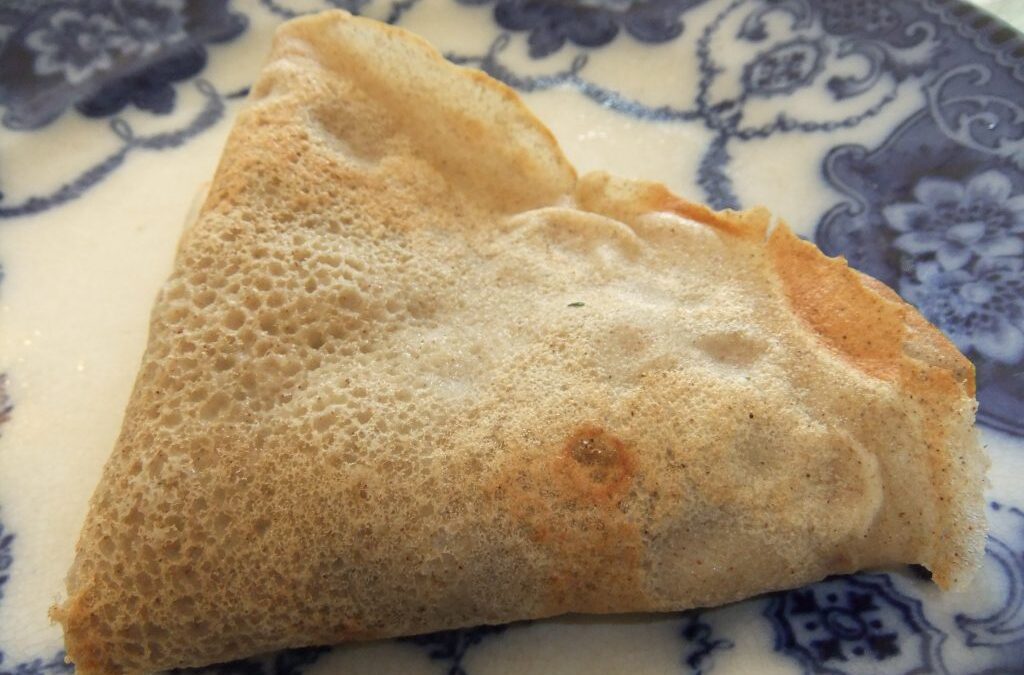
Apr 18, 2022 | Anna's Best Recipes, Cakes, biscuits & bars
This is LOVELY! Unlike most gluten-free cakes this stays moist and delicious for days. Just don’t tell anyone that its high protein, gluten-free, almost grain-free and almost totally free of sugar. I got the original idea from a recipe on www.atastylovestory.com but it contained gluten and was packed with immune-disrupting sugar. So I adapted this recipe https://www.annacollins.ie/ultra-moist-chocolate-cake/ and the toppings in the other recipe. A triumph. And surprisingly easy!
I made the cake this Saturday, served it on Easter Sunday and it was still perfect (from the fridge) on Monday. Can we wait till Tuesday to polish off the rest. That’s the question….
Serves 8-10
For the sponges:
1 heaped plus 1 level tbs cocoa powder
1 heaped plus 1 level tbs rice flour
1 rounded tsp baking soda
1 x 400g tin of black beans, rinsed and drained
3 large eggs (or 4 medium)
140g xylitol or erythritol
1 espresso shot black coffee or strong dandelion coffee
½ tsp vanilla extract (if you’re gluten-free, avoid vanilla “essence”).
50ml almond or cow’s milk (or cherry juice)
10ml kirsch
5ml apple cider vinegar (if you are using cherry juice you don’t need this. Acid activates baking soda)
Pinch of Himalayan or Atlantic sea salt
Silicon or greaseproof paper
Butter or light olive oil for greasing the tin
2 x 25cm loose bottomed cake tins.
For the filling:
2 heaped tbs no-added sugar morello cherry jam. I love St Dalfour (sweetened with fruit juice) or Prunotto sour cherry jam (just 10% sugar instead of the usual 50% in most jams)
1 420g tin cherries in juice or light syrup
300-400ml whipping cream (use double cream if you prefer)
4 drops stevia (or 1 heaped tsp xylitol/erythritol)
½ tsp vanilla extract
30g dark chocolate, at least 80% cocoa solids
To make the sponges:
- Preheat oven to 175C (160C fan).
- Cut 2 circles of silicon/greaseproof paper the same size as the base of your cake tins. Grease and line the tins with the paper. Is the paper is greaseproof rather than silicon, grease the paper too.
- Sieve the rice flour, cocoa and baking soda together into a bowl.
- Blend all the ingredients in a food processor until the mixture is smooth. Don’t be alarmed if the mixture is runny. It’s supposed to be.
- Divide the batter evenly between the 2 cake tines and bake18-20 minutes until a needle/knife inserted into the centre comes out clean.
- Set aside to cool completely before removing from the tins.
To assemble the cake:
- Drain the cherries, retaining the juice/syrup. Mix 100ml of it with the kirsch (the rest is good in cocktails).
- Put each cooled sponge upside down on a separate plate, including the one you want to serve on. This makes it easier for the liquid to soak in fully. Spoon half the syrup/kirsch over the sponges. Leave to sink in. Add more if it’s all absorbed but don’t overload it.
- Whip cream until thick, then add the stevia/erythritol/xylitol and vanilla extract. Whisk until voluminous but not too stiff to spread.
- Set aside 12 of the drained cherries.
- Spread the bottom layer of cake (on the serving plate) with the jam. Arrange the cherries on top (except the reserved 12).
- Spread half the whipped cream in between and over the cherries. Everything will look rustic.
- Carefully slide the top sponge layer into position on top and press down gently.
- Use a palette knife to spread the remaining cream on top in big, puffy waves.
- Grate the chocolate into curls generously over the top.
- Arrange remaining cherries around the edge. Chill for an hour before serving.
Why this is better for you:
Amazingly, theres very little grain in this cake and its high in protein from the eggs and black beans. This makes it suitable for moderate carb diets. Most cakes are sky-high in carbs (flour, sugar) and so are a real stressor on your metabolism.
Yes this cake has got lots of cream but for over 25 years nutrition science knows that eating cholesterol has nothing to do with heart disease. It’s the oxidation (damage) done to cholesterol by high carb diets, nutrient deficiencies and metabolic stress that drives heart disease.
This isn’t a cake for every day because fresh, natural vegetables fruit are healthier choices than baked sweet treats. But sometimes you want CAKE!

Mar 31, 2022 | Anna's Best Recipes, Main courses, Sides, starters, soups & snacks
Just invented this last week from what we had in the fridge. It’s LOVELY with its blend of salty, smokey and fresh flavours. Lovely with a fresh mixed salad. Make sure to buy actual feta which is made from ewe (sheep) or goat milk. Do try to avoid the nasty pitted olives in black water available in supermarkets – they have almost no flavour and are only black because of black food dye. If you want to save, get your black olives in middle Eastern shops where they’re great value.
I don’t add the mint until just before serving as it goes limp quickly.
1 packet (around 200g) feta, cut in bite sized cubes as small as you like
1 large aubergine
Heaped teaspoon (or more) ground coriander
3 dsp extra virgin olive oil (EVOO)
1 dsp lemon juice or apple cider vinegar
Freshly ground black pepper
Handful un-pitted olives (ideally wrinkly dry black ones or kalamata)
Generous handful washed mint leaves
- Turn on grill to high.
- Slice an aubergine in 1cm (or a bit thinner) slices (disks or lengthways, whatever you prefer).
- Put aubergine slices on grill, brush with extra virgin olive oil (EVOO) and sprinkle with a little ground coriander. Grill till golden while you assemble the other ingredients. Then turn and repeat the process. Remove from heat and allow to cool slightly. Cut into bite size pieces or strips (I use a scissors to do this quickly).
- Into a large serving bowl put aubergine, olives, feta, EVOO, lemon juice/vinegar and a few generous grinds of black pepper and gently mix everything.
- Just before serving chop the mint. Sprinkle it over the top or mix it in.
Serve with:
Low carb: A big mixed salad dressed with my favourite dressing https://www.annacollins.ie/mediterranean-salad-dressing/
Medium carb: Salad + something starchy like wholemeal gluten-free bread or (for gluten eaters) a nice wholemeal rye sourdough.
Why this is good for you (provided you’re not dairy-sensitive!):
Goats and sheep’s cheese are high in protein and FAR more easy for humans to digest than cow. Modern (Jersey) cow’s milk contains A1 beta casein which is hard to digest. Goat and sheep milk contains 80% less of this problematic casein. Olives are a fermented food and contain beneficial bacteria to help your gut. Mint, like most herbs/spices, helps make your gut a hostile place for disease-causing bacteria and is also rich in polyphenols. Polyphenols are natural plant compounds shown to be anti-inflammatory, anti-oxidant and hugely supportive of your health – gut, brain, skin and more. What’s not to like?

Jan 30, 2022 | Anna's Best Recipes, Main courses
This is my current favourite way to use tofu or tempeh. I adapted it from Ottolenghi’s more complex recipe. My husband is a tofu-hater so when he disappears for a few days I always cook this. Keep in mind that unfermented soya products contain digestion-blocking proteins that damage your gut. So DO make sure to buy the fermented forms for this dish: tempeh or fermented tofu (it will say on the pack).
If you don’t have a small-bowl food processor, chop the chili finely, crush the garlic and use a pestle and mortar to bash the caraway seeds about as much as you can before mixing with the other spices and oil.
For 2
This is gorgeous served with cauliflower/broccoli “rice”, konjac noodles or brown basmati rice.
350g trimmed French (or use runner beans cut in 6cm bits)
Salt and black pepper
200g non-GMO tempeh or fermented tofu, cut into bite size cubes
A few sprigs of dill (small handful), destalked and roughly chopped
Small handful fresh coriander, destalked and roughly chopped
For the sauce:
4 garlic cloves, peeled and crushed
1 green or red chili, deseeded (optional)
2 slightly rounded tsp sweet paprika
1 tbs caraway seeds
1.5 tsp ground cumin
½ level tsp ground Ceylon cinnamon
2 tbs + a little extra avocado oil or extra virgin olive oil
3 tbs tomato puree
250ml water or leftover vegetable-steaming water (full of nutrients!)
Optional: 1 heaped tsp honey or non-toxic sweetener e.g. Dr Coy’s Stevia Erylite or xylitol (from good health stores)
2 limes
Black pepper
Himalayan or sea salt
- For the sauce put the garlic, spices, chili and 2 tbs oil in the small bowl of the food processer and blitz to a thick paste. You might need a touch more oil to bring it together.
- Heat a pan on a medium heat and add a teaspoon more of avocado/olive oil and stir fry the garlic-spice mix for 30 seconds.
- Then add the tomato puree, 250ml water and bring to the boil.
- Stir in the honey or non-toxic sweetener, lime juice, generous pinch (1/4 a level tsp) salt and a few good grinds of black pepper.
- Add the tempeh, turn down the heat, cover and simmer while you prep the green veg.
- Steam the French/runner beans for around 2-3 minutes until the colour changes very slightly and they are softened but still have a bit of crunch.
- Finally, just before serving, stir the herbs into the tofu and sauce, pile on top of your rice and enjoy.
Serve with:
Low carb: Cauliflower or broccoli rice https://www.annacollins.ie/cauliflower-rice/ or konjac noodles from Asian stores.
Medium carb: brown basmati rice cooked with a generous pinch of turmeric
Why this is good for you:
Spices are a powerhouse of antioxidants that help rebalance your gut bacteria in favour of the good guys. The good guys helps digest your food, repair and maintain your gut lining every minute of every day, and reduce inflammation in you. This has massive implications for your immune system, your gut health and even your mood. Yes, anxiety/depression states always involve brain inflammation. Type the name of just one spice into medline (the scientific journal resource) and you’ll find hundreds of peer-reviewed scientific studies.

Dec 21, 2021 | Anna's Best Recipes, Cakes, biscuits & bars
Before I found out that I was coeliac I LOVED the occasional slice of Stollen (I’m a sucker for marzipan in cakes). It’s been a decade since I’ve eaten stollen. Most commercial gluten-free ones are loaded with energy-sapping ingredients like sugar, corn, vegetables oil and emulsifiers. So this year I went on the hunt for a decent GF recipe.
I made this last week by slightly adapting the lovely www.rosielovestea.com recipe by Cindy Jarvis (hope you don’t mind, Cindy, your photo was better than mine so I borrowed it!). A few changes like avoiding palm shortening and sugar-laden marzipan and adjusting the oven temperature to 160C for fan oven. It’s big and gorgeous but nonetheless two of us demolished it within 5 days.
Get your fancy flours in and your marzipan made in advance. I didn’t. So the whole thing became a bit of a production.
20 servings
Prep time: 90 mins Cook time: 1 hour
300g Bobs Red Mill Paleo Flour OR make your own by mixing 2 cups almond flour/fine ground almonds, 1 cup arrowroot powder, ½ cup coconut flour and ½ cup tapioca flour
240g (1 cup) tinned coconut whipping cream (Biona and Amaizin are toxin-free)
50g coconut oil at room temperature (use butter if you’re not dairy-free)
2 large eggs
2 tbs of honey/agave/maple Syrup
2 tbs grated lemon zest
2 tsp baking powder
1 tsp vanilla extract (PS “vanilla essence” contains gluten!)
Pinch of salt
150g sultanas
55g flaked almonds
225g marzipan – for recipe see https://www.annacollins.ie/almond-paste-marzipan/
1 cup of no added sugar jam (Follain/St Dalfour raspberry is good) or home-made raspberry chia jam like this one https://www.annacollins.ie/10-minute-chia-seed-jam-raspberry-strawberry-blueberry-or/
Optional (for a glistening snow-like effect on top):
1 tbs melted coconut oil + 2 tablespoons of arrowroot Powder
- In a food processor, combine coconut whipping cream, 50g coconut oil, eggs, honey/syrup & vanilla extract.
- Next, add paleo flour, baking powder and salt. Mix until well combined and pastry-like. You want it firm enough it will hold its shape when you roll it out and roll up with the fillings inside. If your dough is too runny, sprinkle a little more flour in.
- Add the lemon zest, sultanas and flaked almonds and gently combine.
- Turn out onto a plate or bowl, cover and place in the fridge for around 1 hour
- Preheat oven to 175C/fan 160C and line a baking sheet with parchment paper.While the oven is heating, take the dough from the fridge. Between two pieces of parchment paper, roll out the dough to roughly 1/2 inch thick.
- Cut the marzipan into 3 pieces, roll into sausage shapes and lay evenly on the dough.
- Spoon out the jam in between the marzipan pieces.
- Carefully roll up the dough, tuck in the edges and gently place onto your baking sheet. Put in the oven for 60 minutes. Keep an eye on your stollen so that it doesn’t brown too quickly. If this is the case, cover with foil for the remaining time.
- The stollen will be ready when golden brown and an inserted skewer will come out clean.
- Melt your 1 tbs coconut oil, brush over the top and then dust with arrowroot powder for a glistening snowy effect.
- Leave too cool completely (overnight preferably) before cutting into and serving.
- Store in an airtight container for up to 7 days.
Why this is better for you:
OK so you know that raw nuts are better for you than cooked. And that most of our food should be vegetables and some fruit. But sometimes you just WANT CAKE! Because this is high protein (almonds) and sugar-free so won’t derail blood sugar and immunity like sugar and refined flours do.

Oct 23, 2020 | Anna's Best Recipes, Main courses
My mother sent me the recipe cut out of the newspaper and I love it. Just the thing for a cold, dark Autumn night as we all stay in our houses. Many of my patients find that a paleo-style diet (vegetable-rich, virtually grain-free, dairy-free with meat, fish, eggs and good fats) makes them feel SO much better than a so-called “healthy diet” that is overloaded with grains and potatoes. The proof of the pudding is in the eating. This pot roast comes with its own gorgeous rich brown sauce. I love this pot roast because its delicious on the day and I can use leftovers sliced and either reheated in the sauce. Leftovers are your friend if you love eating well but don’t want to spend hours every night in the kitchen. We often eat this with cauliflower mash and a steamed green vegetable like cabbage, broccoli or green beans. Yum…
If you want to feed resolute carnivores and those who want to eat less red meat at the same meal simply add cooked butterbeans about 20 minutes before the end of cooking. They take up the fabulous flavour and are rich in protein.
1kg pot-roasting beef (housekeepers’s cut or topside). This will come tied up with string which stays on till you serve it.
Extra virgin olive oil
2 tbs tamari sauce (avoid if on SC diet)
6 tbs dry white wine
2 star anise (this makes the sauce extra flavoursome)
1 large/2 small cloves garlic, roughly chopped
1 rounded teaspoon raw cane molasses
Freshly ground black pepper to taste
2 onions, each peeled and cut in 8 wedges
2 large carrots, diced roughly
1 heaped tsp arrowroot powder (from health shops) to thicken
1. Preheat a heavy casserole, then add a knob of extra virgin olive oil and sear the beef for a minute each side until very lightly browned (browning isn’t essential, you can go straight to step 2 if you want).
2. Add the tamari sauce, wine, star anise, garlic, close tightly and simmer gently o the top of the stove or in a low oven or slow cooker for an hour.
3. Meanwhile dice the carrots roughly, peel and cut each onion into 8 wedges.
4. Add the molasses, some freshly ground black pepper, carrots, onion, and continue to cook very gently for a further 1½ hours. When cooked, remove the beef and keep warm.
5. If you want to increase the amount of sauce, add a little water (or some leftover vegetable-steaming water).
6. Blend a teaspoonful of arrowroot with a little water, add in a little of the hot liquid, then add to the juices in the casserole and bring up to the boil, stirring, until the sauce thickens and clears.
Serve with:
LOTS of steamed green veg and some mashed Swede turnip or cauliflower mash.
Why this is good for you:
Long slow cooking is much preferable to cooking at high temperatures because fewer toxic byproducts are created to would cause more inflammation in your body. For this reason, browning a single large piece of meat is better than browning small pieces. When I’m feeling really healthy I don’t brown this pot roast at all and it still tastes delicious – the sauce is so rich. Red meat contains acetyl-carnitine. For people with serious energy problems (eg M.E./chronic fatigue syndrome/long covid) eating foods that contain acetyl-carnitine every day can bring about great improvements in energy.

May 27, 2020 | Anna's Best Recipes, Main courses
I love stir fries especially when I want to use up what’s lurking in the bottom of the fridge. I think there are 6 elements in a good stir fry:
1. Aromatics: ginger, tamari sauce plus Chinese 5 spice powder or Szechuan pepper
2. Onions or spring onions
3. Vegetables: greens plus something else brightly coloured
4. Extra virgin coconut oil and/or chicken stock for the actual stir frying and cooking
5. Protein: e.g. chicken fillets, beef sirloin, tempeh, fermented tofu, prawns
6. Extra liquid: I like a glug of white wine/dry sherry and/or a chicken/veg stock/water
One of the keys is to have all ingredients totally prepped before you start to stir fry, that way the actual cooking can take as little as 10 minutes. Get your accompaniment (rice/cauliflower rice/noodles) ready and waiting in a warm place before you start stir frying.
Once you are used to making stir fries you’ll start adding your own twists, using additional veggies and making this your own.
For 2
1 heaped teaspoon extra virgin coconut oil
1 large onion (about 200g is nice)
2 large red peppers/2 medium carrots (or 1 pepper 1 carrot)
1 thumb of ginger (enough to make a heaped dsp or a bit more)
2 large cloves of garlic, finely chopped
1 heaped tsp Chinese 5 spice powder – if you make your own it’s amazing https://www.annacollins.ie/chinese-five-spice-powder/
2 large handfuls greens: e.g. green cabbage/kale, pak choi, or 2 cups small broccoli florets
Tamari sauce – about 2 tbs
Optional – about 2 tbs white wine or dry sherry
50-100ml vegetable or chicken stock or boiling water (Kallo stock cubes or Vecon vegetable bouillon powder are good)
Protein: 250g chicken fillet/beef sirloin or 300g tempeh or fermented tofu
Optional: 1 slightly rounded tsp arrowroot powder/cornflour to thicken the sauce
To serve:
2-3 cups cauliflower rice https://www.annacollins.ie/cauliflower-rice OR 100g basmati rice (dry weight)
1.Peel and cut onion in half lengthways then cut into wedges (like segments of an orange)
2.Slice red peppers 1cm thick/peel carrots and cut into thin matchsticks or slices.
3. Peel and chop the ginger finely. Set aside the onion, carrot/peppers and ginger – they will be added to the pan together.
4.Measure out 5 spice powder and set aside.
5.Shred greens/slice pak choi into 3cm lengths/break broccoli into small florets, chop garlic finely and set aside.
6. Prep your protein: trim chicken/beef of skin/fat, slice thinly across the grain (less than 1cm thick). If you are using tempeh/fermented tofu cut it in small bite sized cubes.
7. Measure out the tamari sauce with the sherry/wine if using and set aside.
8. Boil the kettle. If you have chicken stock/veg stock cube make up about 50-100ml, otherwise plain hot water will do.
9.Heat your frying pan or wok on a medium heat, add the coconut oil and when it’s melted add the onion, red peppers/carrots and ginger and the 5-spice powder. Stir fry till the onions are starting to get translucent and the carrots/peppers have softened a little. If it starts to “catch” add a splash of stock or water to the pan and stir will it’s all unstuck.
10.Add the garlic, shredded/sliced greens/broccoli florets, meat or tempeh the tamari sauce, sherry/wine, give it a stir to coat and cover the pan with a large place or a lid. You want everything to steam until the greens are softened enough to eat but not so cooked that they lose their fresh colour.
11.After a few minutes, stir and check that the meat is getting in contact with the heat and cooking through.
12. When the meat/tofu/tempeh is cooked through check the liquid levels.
13. If you like your sauce thickened, combine 1 tsp cornflour/arrowroot with a few tablespoons of cooled stock or water, mix to amalgamate. Pour on to the pan, stirring well until it’s all cooked (a couple of minutes), adding a splash or water of stock if you think its too thick. Once its thickened and no longer has a chalky taste, its cooked.
Serve with:
Cauliflower rice or rice
Why this is good for you:
Having a big diversity of vegetables, herbs and spices in your weekly eating fosters diversity of friendly bugs in your large intestine. This is important for ALL aspects of your health. Good bugs are critical for mood, getting autoimmune conditions into remission, regulating your weight your blood pressure and even blood sugar. Yes, even diabetes responds to a change in gut bacteria. In short, if want to get well, or continue to enjoy fantastic health, you need plenty of types of good bugs living happily in you.
Garlic and spices selectively reduce numbers of “bad” gut micro organisms and encourage growth of helpful ones. Avoiding polyunsaturated vegetables oils and switching to extra virgin coconut oil (or extra virgin olive oil) for cooking means reducing the toxic trans fats that sabotage the function of every cell in your body.
Quality protein needs to make up 1/4 of your every meal. You need enough protein to be resilient to stress, to power detoxification of normal (and environmental) toxins, and to support your immune system. GMO-free Tempeh or fermented tofu are the highest protein vegan food sources. By soya milk, soya “cheese”, and unfermented tofu are high in substances called lectins, which can cause damage and inflammation in our gut. Damage in your gut fuels ALL chronic health issues from acne and anxiey.
Green veg are a rich source of magnesium, Nature’s Tranquiliser – important for over 400 metabolic processes in YOU. Happy eating!

Apr 29, 2020 | Anna's Best Recipes, Main courses, Sides, starters, soups & snacks
I wish I could claim this idea as my own but every supermarket now sells spiralized courgettes for you to use instead of pasta. The oil and salt lift courgetti from being worthy to being delicious. I used to make a lot of wholemeal pasta dinners until I studied nutrition. Then I realised the large proportion of starchy foods in meals was contributing to my fatigue, frequent infections and poor stress tolerance. Rebalancing my plate helped me enormously within days.
For 2 people
2 medium courgettes
2 dsp extra virgin olive oil (more if you want!)
Pinch of Himalayan salt or sea salt
1. Make long strands of courgette: Either grate them lengthways (skin and all) on the big side of your grater or use a spiralizer.
2. Heat a frying pan on a medium heat. Add the olive oil, the courgetti and scatter over a generous pinch of salt.
3. Now heat, stirring every so often, for around 5 minutes. You want them heated, VERY slightly softened, but not so soft they release water and go into a bit of a mush. It took me a few tries to get this right!
4. Serve immediately with your pasta sauce. Enjoy!
 Why this is good for you:
Why this is good for you:
When we eat more than 1/4 of our lunch and dinner as high carb foods (e.g. pasta, potatoes, bread) it makes us more likely to struggle with poor detoxification (acne, PMS, headaches or fatigue anyone?). Your body stores excessive sugars as fat and this is why reducing carbohydrates to modest levels helps so quickly in getting you to your ideal weight. Farmers know that one of the fastest ways of fattening their livestock for market is to switch from grass-feeding to grain-feeding. Excessive sugars come not only from “healthy” grains, potatoes and fruit juice but also (even more) from added sugar foods like biscuits, cakes and “fruit juice drinks”.
About wheat pasta: Did you know that gluten breeches the lining of your small intestine within minutes of reaching it? This allows gut bacteria, waste and undigested food to flood into your bloodstream. It’s called increased intestinal permeability and lasts for a minimum of 3 hours. This has been proven by ground-breaking research using capsule video cameras swallowed by HEALTHY STUDY VOLUNTEERS. This is not related to gluten sensitivity or coeliac disease. It happens to everyone though its effects are more serious in those groups. So finding ways to lower gluten in our daily eating is a great way of moving towards better health. Looking after your gut lining makes you less likely to suffer sepsis should you become very ill with an infection. Low gluten grain choices include sourdough bread and oats. If you have an autoimmune condition like hypothyroidism (90% is autoimmune) you will need to switch to naturally (not highly processed!) gluten-free options.

Apr 4, 2020 | Anna's Best Recipes, Desserts & drinks
I have adapted this from the recipe by littlejarofspices. Had it last week and it was GORGEOUS. The original recipe uses an additional 2 tbs of coconut sugar which after the first 10 minutes of baking you sprinkle over the top of the clafoutis to give a caramelised top. I didn’t bother. A dollop of coconut-based yoghurt or whipped cream is lovely on the side. I personally used half gluten free flour (my own blend of sorghum, millet and oat flours) and half finely ground almonds but either works well.
Makes 8 servings
4 stalks (200g) of rhubarb
4 medium eggs
100g almond flour (finely ground almonds give a nice smooth texture, or use your own blend of gluten-free flour flour or glutinacious)
45g coconut sugar (for a lovely caramel flavour)
70g xylitol or erythritol (e.g. Dr Coy’s Stevia Erylite)
250 ml unsweetened almond milk, coconut milk or milk
1 tsp vanilla extract (vanilla “essence” contains gluten)
Coconut oil (or if you eat dairy, butter) for greasing
Pinch of pink salt or sea salt
1.Preheat oven to 190°C and grease a ceramic pie dish/pyrex dish with butter or coconut oil.
2.Wash the rhubarb stalks, chop off and discard the ends and cut them into 2.5 cm pieces and place them in the dish.
4. In a bowl, combine almond flour/gluten-free flour, coconut sugar, xylitol/erythritol and salt. Whisk in the eggs, milk and vanilla extract. The batter should be very thin & liquid.
5. Pour the batter over the rhubarb pieces in the pie dish and place in the oven on the middle rack. Bake for 25 minutes. If it still looks very very liquid in the centre, you might need to give it another 10 minutes until just set.
6. Let cool around 20 minutes before serving.
Why this is better for you:
This avoids a lot of the problems of conventional sugar which suppresses immunity and raises inflammation. Coconut sugar has a lower glycaemic index than sugar and still contains some nutrients. But do remember that coconut sugar is still a high carbohydrate (high natural sugar) ingredient. So this dessert isn’t a staple but more of a weekend or special treat.

Mar 15, 2020 | Anna's Best Recipes, Cakes, biscuits & bars, Desserts & drinks
St. Patrick’s day home-baked treat, anyone? This is lovely and moist and soaked in rosewater and lemon syrup. Make it at least 2 hours before you want to serve it so the syrup has time to soak in. You can buy unsalted shelled pistachios in Middle Eastern and Asian Stores. The recipe, adapted by me to be healthier, is from Claudia Roden’s Arabesque. I am including 2 sizes of cake so you don’t have to go with enormous all the time, if you don’t have 12 people to serve. I increased the amount of lemon, to give a little more tang, and switched the immuno-suppressing sugar for xylitol/erythritol (from health shops). If you want to make serving this more spectacular, get yourself some rosepetals/rosebuds from a Middle Eastern shop and crumble some of the rose petals around and on top of each slice.
To serve 6
Cake:
3 eggs, seperated
60g xylitol or erythritol
25g coarsely chopped raw unsalted pistachios (optional)
100g pistachio flour (finely ground raw unsalted pistachios)
1 x 10-13cm round loose-bottomed cake tin
Syrup for small cake:
75g xylitol/erythritol
90ml water
1 tbs lemon juice
1 tbs rosewater
To serve (optional):
125ml Abbot Kinney’s/Coyo non dairy coconut yoghurt or whipped cream (I like to mix in a few drops of rosewater to either)
Large cake (to serve 12)
5 eggs, seperated
120g xylitol/erythritol
50g coarsely chopped raw unsalted pistachios (optional)
200g pistachio flour (finely ground raw unsalted pistachios)
1 x 23-25 cm round loose-bottomed cake tin
Syrup for large cake:
150g xylitol/erythritol
180ml water
2 tbs lemon juice
2 tbs rosewater
To serve (optional):
250ml Abbot Kinney’s/Coyo non dairy coconut yoghurt or whipped cream (I like to mix in a few drops of rosewater to either)
1. Make the syrup. Bring the xylitol/erythritol, water and lemon juice to the boil, simmer till everything is dissolved. Stir in the rosewater.
2. Let the syrup cool, then chill it.
3. Beat the egg yolks with the xylitol/erythritol to a pale cream, then add the ground pistachios and mix very well. Beat the egg whites until still and fold in gently. Pour into a greased cake tin and sprinkle the coarsely chopped pistachios, if using, on top.
4. Bake in pre-heated oven (180C/fan 165C).
Test for done-ness (where needle or point of knife comes out clean) after 35 minutes for the small cake and 40 minutes for the large, which should take around 45 minutes. If the cake is still sticky, give another 5 minutes, then test again.
5. Turn the cake onto a deep serving dish. Make little holes over the top with a fork and pour over the syrup. The holes will let it soak in quickly.
6. Serve, if you like, with the coconut yoghurt or (if you’re not dairy sensitive) cream.
Why this is better for you:
OK, so raw nuts are much better than baked (because nut/seed oils get damaged by heat) but this cake is high in protein and contains no sugar. This means it won’t disrupt blood sugar levels. Maintaining blood sugar balance is important if you care about your vitality and health. Erratic blood sugar levels contribute to fatigue, mood issues, inflammation, auto-immune conditions and so, so much more. Stay well.

Feb 21, 2020 | Anna's Best Recipes, Desserts & drinks
I LOVE these. Heard a recipe on the radio using cheese but I swapped it out for full fat thick natural yogurt or strained kefir (you strain the kefir through a muslin in a sieve to thicken it) an it’s DELICIOUS. I quite like my pancake Tuesday pancakes with lemon juice and some honey or Dr Coys Erylite or Xylitol to sweeten. But you could use stewed apple, apple puree and a big dollop of cream or non-dairy coconut yoghurt on top if you feel the urge. If you are a bit dairy sensitive like me, home-made kefir could be the one form of dairy that you can tolerate really really well. That’s because the process completely breaks down the lactose, as well as the casein protein, which is what most people have a problem with. YUM!! Would you like me to do a post on how to make kefir? If so, give me some feedback.
Makes 4 large pancakes (you can use normal oats/oat flour if you are not gluten-sensitive)
50g gluten-free oats, blitzed in the food processor to make a flour (or use Merry Mill gluten-free oat flour from good health stores like the Hopsack in Dublin 6)
4 eggs, organic if possible
Pinch of salt
1/2 tsp Ceylon cinnamon powder
1/2 tsp vanilla powder or extract (avoid “essence” – it contains gluten)
10 drops pure stevia (optional) – I like “sweet drops of stevia” form health stores
150ml (10 tbs) natural full-fat yogurt, Greek yogurt or thickened kefir (strain home-made kefir through a sieve lined with muslin/kitchen paper and use the thick stuff that remains)
Optional: 1/2 tsp gluten-free baking powder (makes a fluffier, higher pancake, more like a drop scone)
- Bitz all the ingredients together in a blender (or using a large bowl add the dry ingredients and mix well. Make a well in the middle of the dry ingredients, add the eggs, mix with a wooden spoon, add the wet ingredients and beat until everything is smooth.
- Cook on the pan using extra virgin coconut oil, avocado oil or (a bit less healthy) light olive oil.
- Enjoy…
Why this is better for you:
Ceylon cinnamon helps balance your blood sugar and prevent diabetes!! Stevia is a more natural sweetener than most others and contains no calories. Like erythritol and xylitol from health stores, stevia does not raise your blood sugar levels – so this is a friendly recipe for anyone who cares about their health or has blood sugar issues like diabetes.
Oats are a great source of soluble fibre, which feeds some of your good gut bacteria to help all aspect of your health, mental and physical. So much better than wheat because lower in gluten. Published video evidence now proves that gluten damages your small intestine for at least 3 hours. This study was done on non-gluten-sensitive people. Yes, that includes all your normal people out there. Damaging your gut allows undigested food, bacterial cell walls and toxins to spill into your bloodstream. This eventually compromises your health by inflaming either your brain or other parts of you.
Eggs are a high quality source of protein and (if they are organic) omega 3 fatty acids and phospholipids which our brains and cell membranes need for every function of our body. Please don’t be afraid of eggs (unless you are sensitive or allergic). Eggs do not give you heart disease. The 1950’s study showing eggs cause heart disease was carried out on rabbits. Rabbits are vegan! Unlike us, they can’t cope with animal protein. The real culprit with heart disease is a high grain carbohydrate diets, inflammation and lack of beneficial fats, quality protein and vegetables, herbs and spices.
